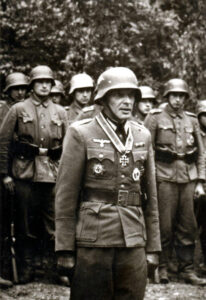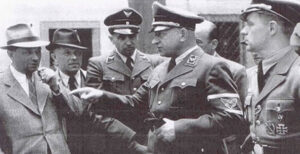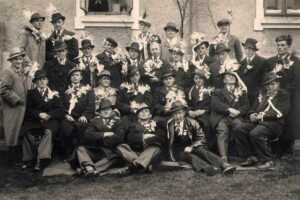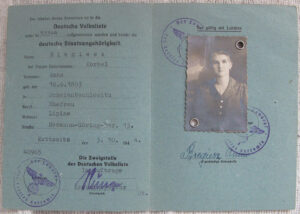Or otherwise?
Czechs fighting for Hitler? Despite Adolf Hitler’s explicit declaration against including Czechs in his army and the Nazis‘ view of Czechs and other Slavs as inferior according to their twisted racial theories, over three-quarters of a million individuals were drafted into the Nazi army from the Czech lands. How is this possible? Did the Nazis change their attitude, or were there so many renegades among the Czechs? Or is there another explanation? During the interwar period, Czechoslovakia was one of the most ethnically diverse countries in Europe. In the Czech lands alone, out of a population of ten million, up to three million identified as German—a group often, though not accurately, referred to as „Sudeten Germans.“ However, a significant number of other Czechoslovaks also ended up wearing the German uniform.

Most of the Germans living in the Czech lands succumbed to Nazi ideology. Rough estimates suggest that about half a million of these former Czechoslovak citizens served in the Nazi army. Some even achieved distinguished careers in the German military, rising to high ranks or becoming renowned aces in the Luftwaffe, Panzer divisions, or U-boat fleet.

Apart from those of purely German ethnicity and clear renegades, many others were also impacted by Nazi Germanization efforts: husbands and sons from mixed marriages, men with even minor German ancestry, Czechs working in Germany, German or Austrian citizens of Czech origin, such as Viennese Czechs, and various specific groups with mixed populations, such as the Silesians.

In Upper Silesia, a region divided between Germany, Poland, and Czechoslovakia, the majority of the population was of Slavic origin and spoke a Slavic language. For a long time, they were influenced by all three national centers, with the German influence being particularly significant. However, their identity was largely “local,” with nationality not being a fundamental part of their personal identity.

The Nazis applied various measures to pressure Czechs with German ancestry or roots, particularly the Silesians, to declare their “Germanness.” They offered benefits as incentives, but also threatened severe consequences for refusal, including the loss of employment and property. In extreme cases, imprisonment or deportation to concentration camps was also a possibility.

Many of the forcibly mobilized Czechs and Silesians reluctantly submitted and donned the German uniform. However, most sought to survive the war and often chose captivity over giving their lives for the Nazis. Nevertheless, up to four thousand of these men eventually joined the Czechoslovak exile army. For the Polish exile army, up to 80,000 (!) former POWs were recruited up to the war’s end.
WHICH SIDE TO STAND ON
Initially, the Nazis conscripted only those of German ethnicity from the Czech lands, primarily the so-called Sudeten Germans, for military service. It’s estimated that over half a million of them may have served during the war. Military service for ethnic Czechs was not originally intended. However, some Czechs became victims of Germanization efforts.
These individuals were primarily spouses and sons from mixed marriages, as well as those with German ancestors or other ties to the German community. They were pressured, often under direct threats, to declare their German nationality. Those who succumbed to this pressure eventually found themselves enlisted in the German army.
As in other occupied countries, the Nazis directed their Germanization efforts in the Czech lands toward groups influenced by the German cultural or linguistic environment who also differed from the majority “enemy” populations, such as the Czechs and Poles. In the Czech lands, this primarily targeted the inhabitants of the Czechoslovak part of Silesia.
In this region of Silesia, several hundred thousand Slavic inhabitants lived under the influence of three powerful national centers—Bohemia, Poland, and Germany. Each of these national currents laid claim to Silesia. However, the blending of these different influences meant that nationality often did not play a central role in the locals‘ personal identity.
The Nazis offered certain advantages to those Silesians who, despite their “Silesian” nationality, subscribed to a program of gradual Germanization. Refusal, however, was met with threats of losing employment, property, and in some cases, imprisonment. Consequently, most Silesians complied. Eventually, these individuals were subjected to military duty, and several tens of thousands of Czechoslovak Silesians were required to wear the German uniform. After the Sudeten Germans, they constituted the second largest group of Czechoslovak citizens serving in the Nazi army.
Like their approach to other “non-German” soldiers, the Nazis generally had little trust in Czechs and Silesians. They were dispersed across various military units, rarely serving together in large groups. While some conscripts actively supported Nazi ideology, most merely sought to survive the war. They sought various means to escape from the German uniform. Especially toward the war’s end, desertions, voluntary captivity, and defections became increasingly common.
While in Allied captivity, some of these conscripts joined the Czechoslovak or other Allied armies. This was not a small group; by the end of the war, nearly four thousand had joined the Czechoslovak exile army. Among them were ethnic Czechs who had succumbed to Germanization pressures, as well as Czech compatriots from Germany and Austria, a handful of German anti-fascists, but the majority were Silesians.
Their motivations for switching sides and fighting against the Nazis were diverse. In addition to patriotism and loyalty to Czechoslovakia, concerns about their post-war future played a significant role. Refusing to join the Allies threatened loss of property, civil rights, and potentially even the possibility of returning home—fears that had initially driven them to join the Nazi army.
Once again, individuals caught between conflicting nationalisms were forced to choose a side, but this time on the opposite side of the barricade.

